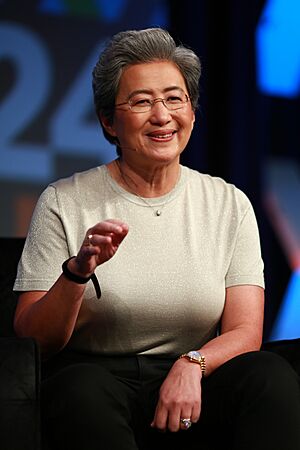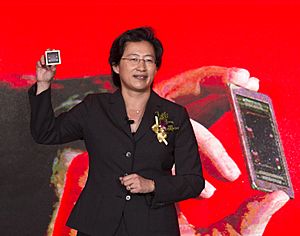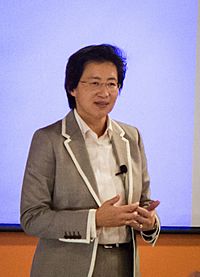Lisa Su facts for kids
Quick facts for kids
Lisa Su
蘇姿丰 |
|||||||||||||||||||
|---|---|---|---|---|---|---|---|---|---|---|---|---|---|---|---|---|---|---|---|

Su in 2024
|
|||||||||||||||||||
| Born |
Lisa Tzwu-Fang Su
November 1969 (age 56) Tainan, Taiwan
|
||||||||||||||||||
| Education | Massachusetts Institute of Technology (BS, MS, PhD) | ||||||||||||||||||
| Known for | Semiconductor design, silicon-on-insulator design | ||||||||||||||||||
| Title | President and CEO of AMD (2014–present) Chair of AMD (2022–present) |
||||||||||||||||||
| Spouse(s) | Daniel Lin | ||||||||||||||||||
| Relatives | Jensen Huang (cousin) | ||||||||||||||||||
| Awards | IEEE Fellow (2009) IEEE Robert N. Noyce Medal (2021) |
||||||||||||||||||
| Scientific career | |||||||||||||||||||
| Fields | Electrical engineering (VLSI) Computer science (digital computer hardware) |
||||||||||||||||||
| Thesis | Extreme-submicrometer silicon-on-insulator (SOI) MOSFETs (1994) | ||||||||||||||||||
| Doctoral advisor |
|
||||||||||||||||||
| Chinese name | |||||||||||||||||||
| Traditional Chinese | 蘇姿丰 | ||||||||||||||||||
| Simplified Chinese | 苏姿丰 | ||||||||||||||||||
|
|||||||||||||||||||
| Signature | |||||||||||||||||||
 |
|||||||||||||||||||
Lisa Tzwu-Fang Su (Chinese: 蘇姿丰; pinyin: Sū Zīfēng; born in 1969) is an American business leader. She is a computer scientist and electrical engineer. Currently, she is the president, CEO, and chair of the company Advanced Micro Devices (AMD). AMD makes important computer parts called semiconductors.
Lisa Su was born in Taiwan. She moved to the United States when she was a child. She earned three degrees from the Massachusetts Institute of Technology (MIT). After college, she worked at companies like Texas Instruments, IBM, and Freescale Semiconductor. She held engineering and management jobs.
She is well-known for her work on silicon-on-insulator technology. This technology helps make computer chips more efficient. She also developed better semiconductor chips while at IBM.
In October 2014, Lisa Su became the president and CEO of AMD. She had joined the company in 2012. Before becoming CEO, she was a senior vice president and chief operating officer. She has also served on the board of Cisco Systems. She is currently on the board of the U.S. Semiconductor Industry Association. She is also a fellow of the Institute of Electrical and Electronics Engineers (IEEE).
Lisa Su has received many awards. EE Times named her Executive of the Year in 2014. Fortune called her one of the World's Greatest Leaders in 2017. She was the first woman to be named Time Magazine CEO of the Year in 2014 and again in 2024. In 2021, she was the first woman to receive the IEEE Robert N. Noyce Medal. Under her leadership, AMD's value has grown a lot. In 2024, she was chosen as a Fellow of the Industrial Technology Research Institute (ITRI).
Contents
Early Life and Education
Lisa Tzwu-Fang Su was born in November 1969 in Tainan, Taiwan. Her family spoke Taiwanese Hokkien. When she was three, she moved to the United States with her parents. Her parents, Su Chun-hwai and Sandy Lo, encouraged her and her brother to study math and science.
Her father, a retired statistician, taught her multiplication tables when she was seven. Her mother, an accountant and later an entrepreneur, taught her about business.
Lisa Su wanted to be an engineer from a young age. She said she was very curious about how things worked. When she was 10, she started taking apart and fixing her brother's remote control cars. She got her first computer, an Apple II, in junior high school. She went to the Bronx High School of Science in New York City. She graduated in 1986.
In the fall of 1986, Su started at the Massachusetts Institute of Technology (MIT). She planned to study electrical engineering or computer science. She chose electrical engineering because it seemed like the hardest major. In her first year, she worked as a research assistant. She made test silicon wafers for graduate students. This work, and her summer jobs at Analog Devices, made her very interested in semiconductors. She focused on this topic throughout her studies. She spent a lot of time in labs designing products.
After getting her bachelor's degree in electrical engineering, Su earned her master's degree from MIT in 1991. From 1990 to 1994, she worked on her Ph.D. in electrical engineering. Her advisors were Dimitri A. Antoniadis and James E. Chung. MIT Technology Review noted that she was one of the first to study silicon-on-insulator (SOI) technology. This technique helps make transistors more efficient. She received her Ph.D. in electrical engineering from MIT in 1994.
Career Journey
Lisa Su has served on the boards of several important organizations. These include Analog Devices, Cisco Systems, Inc., and the U.S. Semiconductor Industry Association. As of 2016, she has written over 40 technical articles. She also co-wrote a book chapter about future electronics.
Early Work at Texas Instruments and IBM
In June 1994, Su joined Texas Instruments. She worked in their Semiconductor Process and Device Center. In February 1995, IBM hired her as a research staff member. She focused on device physics. Later, she became vice president of IBM's semiconductor research and development center.
At IBM, Su helped create a new way to use copper in computer chips. Before, chips used aluminum. Copper made chips up to 20% faster. This new technology became an industry standard in 1998.
Leading Emerging Products at IBM
In 2000, Su worked as a technical assistant for Lou Gerstner, IBM's CEO. After that, she became the director of emerging projects. She started IBM's Emerging Products division. She hired ten people to work on biochips and special semiconductors. Their first product was a microprocessor that made phone batteries last longer. MIT Technology Review named her a "Top Innovator Under 35" in 2001 for this work.
Her division also worked with Sony and Toshiba to create new chips. Their goal was to make game machine processors much faster. Su's team helped develop a nine-processor chip. This chip later became the Cell microprocessor, used in devices like the Sony PlayStation 3. She continued as vice president of the semiconductor research and development center at IBM until May 2007.
Role at Freescale Semiconductor
In June 2007, Su joined Freescale Semiconductor as chief technology officer (CTO). She led the company's research and development until August 2009. From September 2008 to December 2011, she was a senior vice president. She managed Freescale's networking and multimedia group. She was in charge of global strategy and engineering for their communication processors. EE Times said she helped Freescale improve its business.
Joining and Leading AMD
In January 2012, Lisa Su became a senior vice president at AMD. She oversaw the company's global business units. She helped AMD expand beyond the PC market. She worked with Microsoft and Sony to put AMD chips in Xbox One and PS4 game consoles.
On October 8, 2014, AMD announced that Su would be the new president and CEO. She replaced Rory Read. Su said her plan was to invest in the right technologies. She also wanted to simplify the product line and keep diversifying. Many experts praised her appointment because of her strong background.
When Su joined AMD in 2012, only about 10 percent of sales came from non-PC products. By February 2015, this grew to about 40 percent. These sales came from things like video game consoles. In May 2015, Su shared AMD's long-term plan. They would focus on high-performance computing and graphics. This included gaming, data centers, and "immersive platforms."
In January 2016, Su announced new chips called FinFET-based chips. These would create new microprocessors and graphics chips. AMD's stock value went up in July 2016. Fortune said this was due to Su's comeback plan. Key gains in graphics and game console chips helped boost results.
The Ryzen Era
After the Zen chips launched in 2017, AMD's share of the CPU market grew. Ryzen CPUs received good reviews. People liked their high processing power at lower prices than Intel's. This was especially true for high-performance computers.
In February 2022, Su became Chair of AMD. This happened after AMD bought Xilinx, a company that makes special computer chips.
Awards and Recognition
Lisa Su has received many awards. In 2002, MIT Technology Review named her one of the "Top 100 Young Innovators." In 2009, she became a fellow of the Institute of Electrical and Electronics Engineers (IEEE). She was named "2014 Executive of the Year" by EE Times.
In 2015, SFGate nominated her for their Visionary of the Year award. This award honors leaders who make the world better. In 2016, she was named one of the "50 Most Powerful Women in Technology."
In 2017, Fortune called her one of the "World's Greatest Leaders." She was also named "Top Ranked Semiconductor CEO" by Institutional Investor Magazine.
In 2018, Su received the "Women of the Year Award" from UPWARD. She was elected to the National Academy of Engineering. Forbes also listed her among America's Top 50 Women In Tech.
In 2019, Barron's named her one of “The World's Best CEO.” She was also on Fortune's "Most Powerful Women in Business" list.
In 2020, she received the Semiconductor Industry Association's Robert N. Noyce Award. She was also elected to the American Academy of Arts and Sciences. The Carnegie Corporation of New York honored her with the Great Immigrants Award.
In 2021, Su became a Member of the U.S. President's Council of Advisors on Science and Technology. She was also inducted into the Women in Technology Hall of Fame. She received the IEEE Robert N. Noyce Medal, being the first woman to get this award. Forbes listed her among the 100 Most Powerful Women.
In 2022, MIT named its new building 12 after her. This building is for nanotechnology research.
In 2023, Forbes ranked her 49th on its list of "World's 100 most powerful women." Fortune also ranked her 12th on its list of Most Powerful Women.
In 2024, Time included her in its "100 Most Influential People in AI" list. She was also named CEO of the Year by Time in 2024.
Personal Life
Lisa Su and her husband, Daniel Lin, live in Austin, Texas. Lisa Su and Nvidia CEO Jensen Huang are cousins. Her maternal grandfather is the eldest brother of Huang's mother.
As of 2024, Lisa Su's estimated net worth was more than $1 billion.
See also
 In Spanish: Su Lisa para niños
In Spanish: Su Lisa para niños
- List of chief executive officers
- List of IBM alumni
- List of Massachusetts Institute of Technology alumni
- List of women CEOs of Fortune 500 companies
- List of notable people from Tainan



